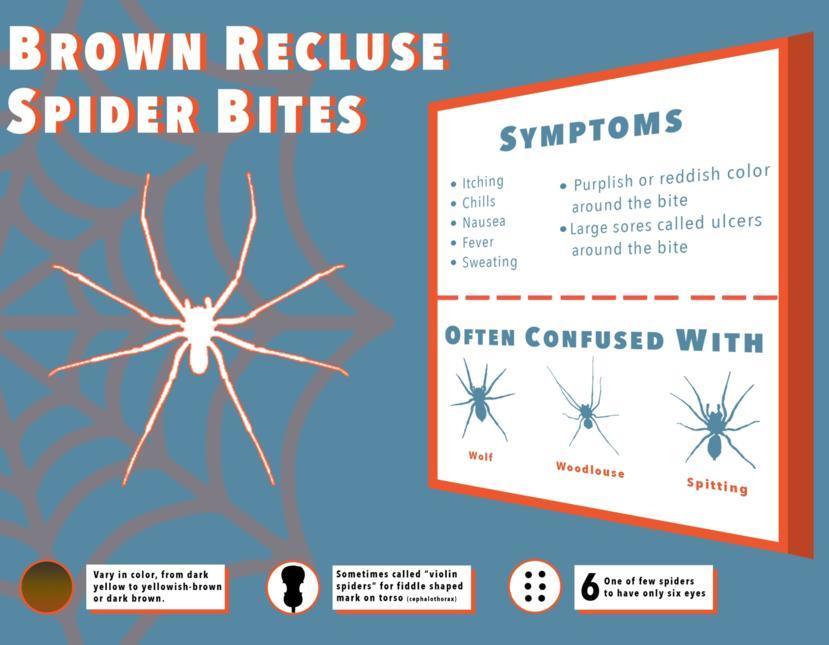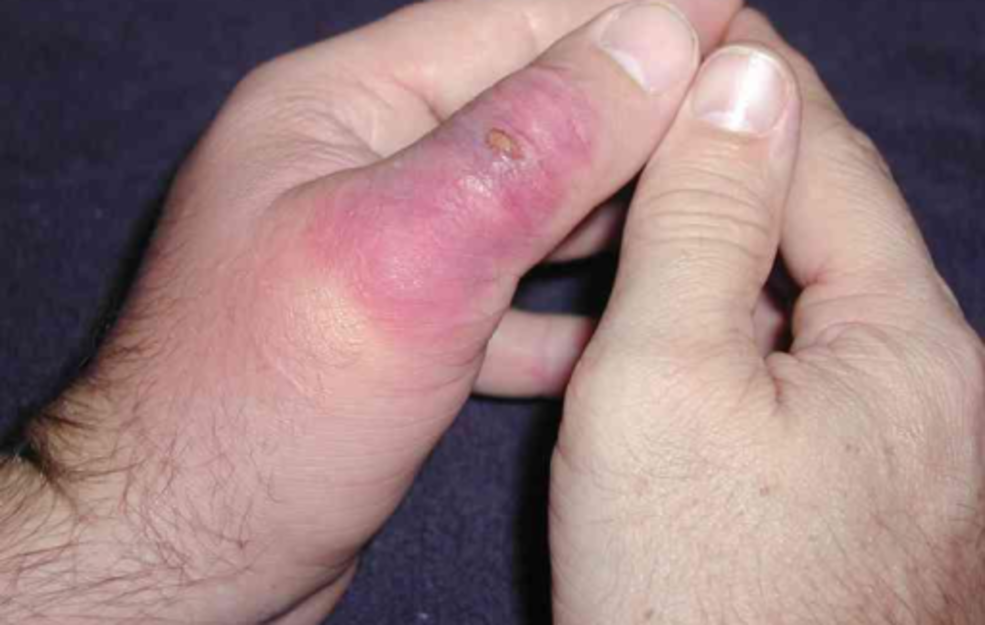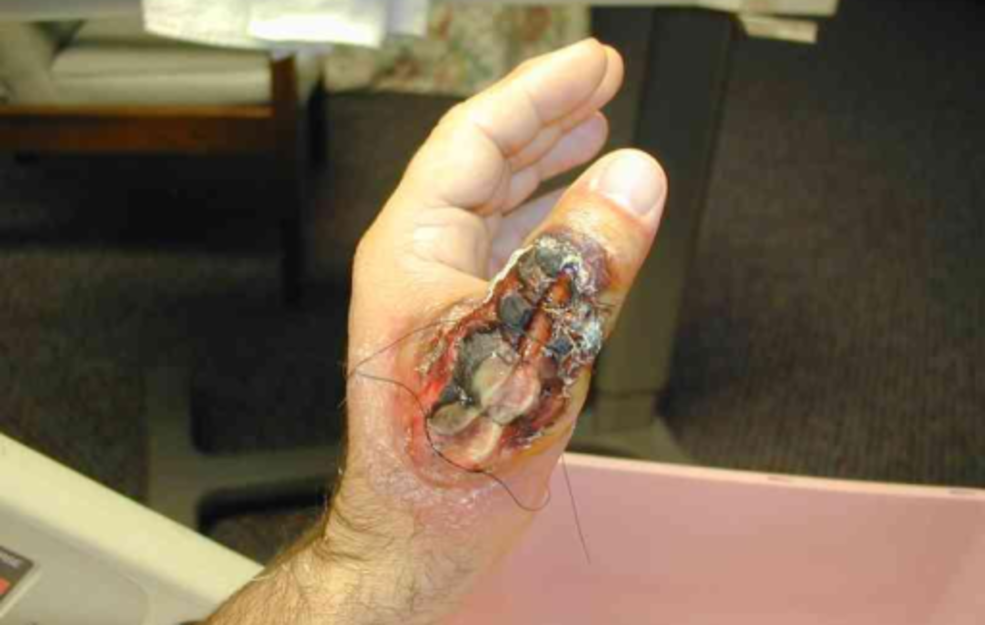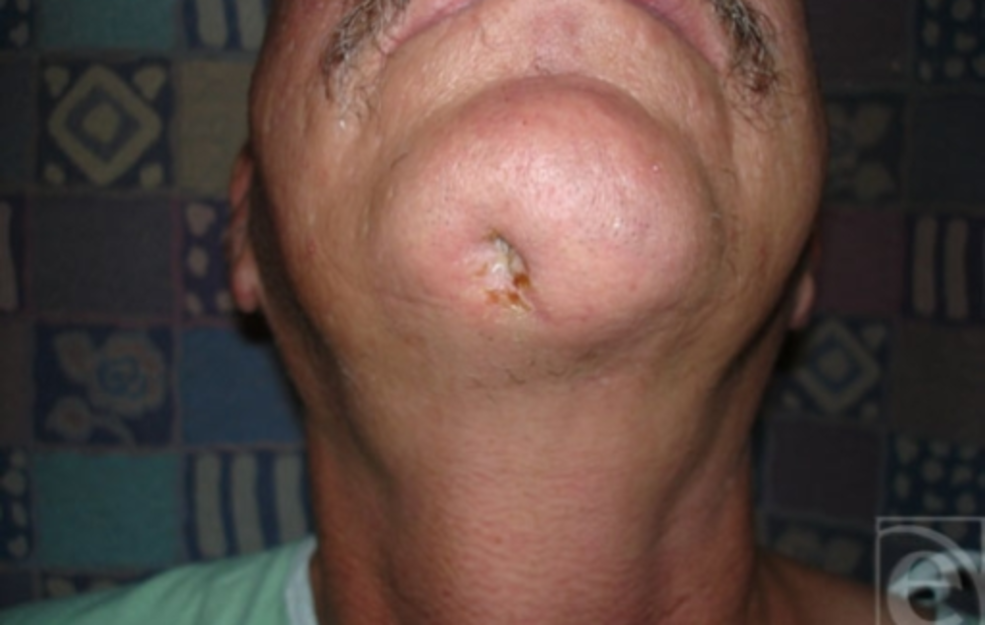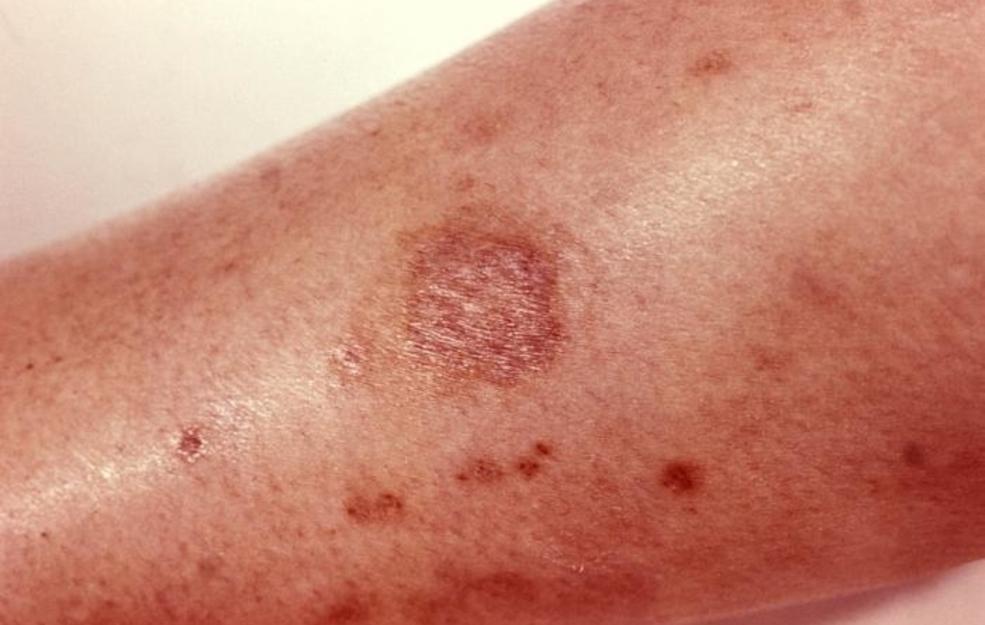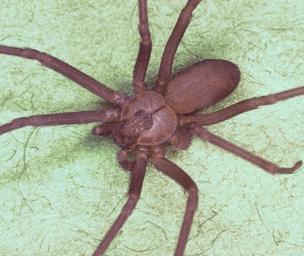Brown Recluse Spider: Bites, Symptoms, and Pictures

What is a brown recluse spider?
A brown recluse spider is notorious for its appearance and poisonous bite. It is the most common brown spider that can be found in the Central and Southern regions of the United States. Brown recluse spiders feed on other insects like cockroaches and caterpillars (both dead and alive). They even feed on other spiders. They hide during the day and go hunting for prey during the night. Interestingly, these spiders don’t build webs to catch insects. When they are hungry, they just hunt for food.
Brown recluse spider bite symptoms
You won’t usually feel a brown recluse spider’s bite until after the action. You might not even realize that you have been bitten by it unless you actually saw it bite you. When you have been bitten by a recluse spider, pain usually progresses within the first few hours and may turn out cruel. Children mostly experience more serious reactions.
Brown recluse spider bite symptoms include:
- Itching
- Chills
- General feeling of sickness or discomfort
- Nausea
- Fever
- Sweating
- Purplish or reddish color around the bite
- Large sores called ulcers around the bite
Treatment for brown recluse spider bites
- Take the bitten person to the emergency room for treatment. The bite may not look serious since it can take some time to become severe. Treatment is important to reduce complications. If possible, place the spider in a secure container and bring it to the emergency room for identification.
- There’s no commercial antivenin (anti-venom) for brown recluse spider bites. If you are bitten, it’s important to go to the nearest emergency room immediately. You may also call 911 or Poison Control.
- Nevertheless, you should wash the bitten area with soap and water. Applying cold compress or ice wrapped in a washcloth on the bitten area for 10 minutes is advisable. Do these things while waiting for rescue or while you’re on your way to the emergency room.
A few medications (doctor-prescribed) can deal with the bite symptoms. They include:
- Muscle relaxants
- Pain relievers
- Corticosteroids (anti-inflammatory medicine)
- NSAIDs (Non-steroidal anti-inflammatory drugs like ibuprofen)
You may also take antibiotics if the bite wound becomes infected.
If the spider bite is situated near a joint like your knee or elbow, your doctor will recommend that you use a brace or sling for the affected limb. With accurate medical attention, you’re going to have a full recovery. However, it may take several weeks for the bite wound, blisters, or ulcers to fully heal.
Confusing differences: Wolf spider vs. Brown recluse spider
A wolf spider and a brown recluse spider are often confused interchangeably because of their comparable appearance. However, there are distinctions between the two. Differentiating them is important because the bite of a wolf spider is not harmful. Brown recluse spiders are venomous, and they can cause damage to the tissues. Wolf spiders also have venom and their bites sting, but they don't cause any lasting damage.
Here are the differences between a wolf spider and brown recluse spider:
1) Markings
A wolf spider doesn’t have an identifiable marking. A brown recluse spider has a marking on its torso (cephalothorax) that resembles a violin, which is why they are sometimes called as “violin spiders”.
2) Eyes
A wolf spider has three rows of eyes with eight eyes in total. The middle two eyes are the most prominent, and the bottom two are the least conspicuous. The two eyes on top are slightly hidden behind bunches of hair. On the other hand, brown recluse spiders are one of the few spiders that have six eyes. Their six eyes are arranged in pairs of three and are clearly visible at the round end of their violin-shaped markings.
3) Legs
A wolf spider has stockier legs with some spines. A brown recluse spider's legs are more slender without spines. Their legs are covered in fine hair.
4) Color
A wolf spider’s abdomen has marks and lines in varying colors, while a brown recluse spider has a uniformly-colored abdomen.
What does a brown recluse spider look like?
Adult varieties of recluse spiders vary in color from dark yellow to yellowish-brown or dark brown. Younger spiders have lighter colors. The brown recluse spider’s abdomen has no spots or stripes. Adult spiders measure about 6-11 mm in length. Their bodies are approximately the size of a U.S. quarter.
As mentioned, the most significant characteristic of a brown recluse spider is its dark, violin-shaped mark on its cephalothorax. The neck of the violin shape is aimed toward the abdomen. To certainly identify a recluse spider, both the violin marking and the eyes must be recognized. If you can see a violin-shaped mark and two pairs of three eyes, you can bet you have a brown recluse spider.
Where do brown recluse spiders live?
Brown recluse spiders inhabit dark and sheltered areas. They can be found in barns, basements, or homes. Brown recluse spiders are mostly found in the Central and Southern parts of the United States.
They are normally found in the following states:
- Oklahoma
- Kansas
- Texa
- Louisiana
- Missouri
- Mississippi
- Arkansas
- Alabama
- Parts of Georgia
- Kentucky
- Tennessee
- Ohio
- Illinois
- Indiana
- Iowa
- Nebraska
According to the Department of Entomology at the University of California, it is highly unlikely for you to find recluse spiders if you’re not in residing in the above-mentioned locations.
Spiders that look like brown recluse spiders
Six-eyed spiders like spitting spiders and woodlouse spiders are frequently misidentified as brown recluses.
- Spitting spiders - are classifiable in a similar sense to brown recluses because of their eyes, but they are non-poisonous. Although they have the same eye patterns, the commonly seen species of spitting spiders have black stripes on both of their abdomen and cephalothorax. This should briefly confirm that they’re not recluse spiders.
- Woodlouse spiders - have six eyes that are grouped densely together in trios near the front margin of their cephalothorax. These spiders are found all throughout the US.
Other brown and eight-eyed spiders that are misidentified as recluse spiders are solpugids and daddy longlegs. Spiders with "violin" markings like the long-legged cellar spiders and pirate spiders are also mistakenly identified as brown recluses.
How to get rid of brown recluse spiders
The nature of a brown recluse spider is to stay hidden in sheltered areas. This makes getting rid of them rather difficult, but still possible. Here are ways to get rid of brown recluse spiders:
1) Dust application
It is regarded as one of the best ways of treating a brown recluse spider infestation. As you already know, brown recluse spiders prefer to hide in secret nooks and corners, dwelling in unseen cracks and untouched places. This is why puffing dust around those secret areas will certainly kill all those brown recluse spiders.
2) Spot treatment
If done alone, this is the least effective procedure. Spot treatment doesn’t assure a good result. Therefore, it must be combined with other kinds of brown recluse spider control.
3) Exterior treatment
Don’t hurry in sealing all openings in the outside walls of your house. Make sure to first treat them with your remaining dust agents to prevent future recluse spiders from entering. All gaps and cracks in your outside walls, vents, pipes, cables, wires, and other exterior items must be treated with dust agents and sealed with caulk.
4) Chemical sprays
Aerosol insecticides can be sprayed directly on brown recluse spiders. This is a sure way of getting rid of those spiders (if you’ve found them).
5) Sanitation
To keep your home from attracting brown recluse spiders, you should maintain the simplest sanitation routines, such as removing all debris away from your home, cutting tall grasses and ground ivy, improving your storage, and reducing clutter. Follow these sanitation rules, and your home will be safe from brown recluses.
6) Glue boards
Another method of getting rid of brown recluse spiders is by using glue boards. This is rather a popular way of catching not only brown recluses but also other insects like cockroaches. Glue boards can be bought at hardware stores and even grocery stores. They are thin and sticky pieces of cardboard. Using more glue boards will get rid of more spiders. The glue boards method should be done before using insecticide agents.
7) Insecticide for spiders
Unfortunately, you can’t trap all brown recluse spiders, especially adult females in your house by just using glue boards. Hence, it will be a good method to apply certain insecticides to the corners, cracks, and other areas where brown recluses can hide.
Important Note: While inspecting your house premises, make sure to wear long-sleeve shirts and gloves to avoid spider bites.
If the infestation of brown recluse spiders is relatively severe, and dealing with it is much more challenging than you thought, you may call the American Association of Poison Control Centers at 1-800-222-1222. Your local poison center can be reached directly by calling this toll-free hotline from anywhere in the US. You can talk to experts about insect poisoning as well as insect bites. They will also provide further instructions. This service is free and confidential. You can call them if you have any concerns about poison prevention. It doesn’t even have to be an emergency. They’re available to assist 24/7.
Are brown recluse spiders poisonous?
Yes. Brown recluse spider (Loxosceles reclusa) venom contains poisonous chemicals. They are known to be one of the most poisonous house spiders in the US. Although the bite of a brown recluse spider in rare occasions can be damaging to tissues, death from a brown recluse spider bite has never been reported.
A brown recluse spider’s bite is immensely poisonous, even more poisonous than that of a rattlesnake’s bite. However, the brown recluse spider’s venom leads to fewer diseases as compared to a rattlesnake’s bite. This is because brown recluses only inject a small amount of venom. Nevertheless, their venom can damage the tissues and cells around the bitten area.
Their venom has enzymes that cause cell membrane destruction. It can disrupt the reliability of tissues and leads to the interruption of blood vessels, fat, and skin, which will eventually lead to necrosis (death of tissues). The venom can trigger an immune reaction in the victim by releasing inflammatory agents such as histamines, cytokines, and interleukins. They signal white blood cells (WBCs) to make their way to the injured area.
Brown recluse spider bite stages
The bite of a brown recluse spider goes through three stages, and all of them occur within the first 24 hours after being bitten.
Here’s the brown recluse spider bite progression:
- Redness and stinging: The spider bite will primarily cause a stinging feeling. This is triggered by the release of the spider’s venom into your blood. The stinging sensation may stop after a few seconds, but may also last for several hours. The stinging feeling is accompanied by inflammation and redness of the affected area. It may also bring about puffiness and thickening of the affected area.
- Pain: You may feel extreme discomfort and pain during this stage, usually about eight hours after being bitten. The pain may turn out to be agonizing over time. This is caused by the immersion of poison in the tissues of your muscle.
- Blister development/ulceration: This last stage usually appears after 24 hours and is characterized by the growth of a blister around the area of the bite. The blisters will start to thicken and will crust over, resulting in an open wound, which will eventually develop into a huge, awful-looking ulcer. These ulcers won’t heal easily. If left untreated, they can lead to secondary infections.
In severe cases, the inflammatory agents in the spider venom can cause injury. Secondary infections of the venom are rare but may cause extensive side effects of the bite such as:
- Destruction of red blood cells (RBCs)
- Low platelet count
- Blood clots in capillaries and loses the ability to form clots where they’re needed
- Kidney damage
- Coma caused by severe injury
Summary
If you live in the Central and Southern regions of the United States, it’s important to recognize what a brown recluse spider looks like. Brown recluse spiders have two pairs of three eyes. They have a violin-shaped marking on their back, and their legs are uniformly colored without spines. Their bites can cause severe pain and even infection at the bitten area after several hours. The symptoms of their bite include redness around the bitten area, severe itching, muscle pain, nausea, vomiting, blisters, and necrosis. If you ever get bitten by this spider, rush to the nearest emergency room for proper treatment. Maintaining a clean home that’s free from clutter will help keep these spiders away.

